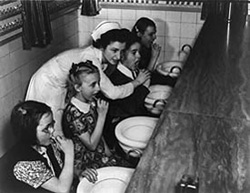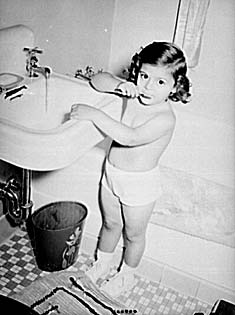

The toothbrush as we know it today was not invented until 1938.
However, early forms of the toothbrush have been in existence
since
3000 BC. Ancient civilizations used a "chew stick," which was
a thin twig with a frayed end. These 'chew sticks' were rubbed
against
the teeth.
The bristle toothbrush, similar to the type used today, was not
invented until 1498 in China. The bristles were actually the stiff,
coarse hairs taken from the back of a hog's neck and attached to
handles made of bone or bamboo.
Boar bristles were used until 1938, when nylon bristles were introduced
by Dupont de Nemours. The first nylon toothbrush was called Doctor
West's Miracle Toothbrush. Later, Americans were influenced by
the disciplined hygiene habits of soldiers from World War II. They
became increasingly concerned
with the practice of good oral hygiene and quickly adopted the
nylon toothbrush.
Some other interesting toothbrush facts:
- The
first mass-produced toothbrush was made by William Addis of
Clerkenwald, England, around 1780.
- The
first American to patent a toothbrush was H. N. Wadsworth,
(patent number 18,653,) on Nov. 7, 1857.
- Mass production
of toothbrushes began in America around 1885.
- One of the first electric
toothbrushes to hit the American market was in 1960. It was marketed
by the Squibb company under the name Broxodent.
 Related
Web Sites Related
Web Sites |
| |
 Further
Reading Further
Reading |
- Asimov,
Isaac, and Carrie Dierks. Why do we need to brush
our teeth? Milwaukee, G. Stevens Pub., 1993. 24
p. (Juvenile).
- Elvin-Lewis,
Memory and Walter H. Lewis. The use of Nature's toothbrush:
the chewing stick. Research Reports - National Geographic
Society, v.16, 1975: 211-231.
- Giscard
d'Estaing, Valerie-Anne. The second world almanac book
of inventions. New York, World Almanac, 1986. 352 p.
- Golden,
Irwin B. Teeth for your lifetime: a complete, easy-to-read,
and understandable guide to a lifetime of dental health.
Upland, Calif., Counterpoint Publications, c1993. 106 p.
- McGrath,
Kimberley A., and Bridget Travers, eds. World of
Invention.
Detroit, Gale, 1999. 1043 (See especially p. 805-806 for
Toothbrush and Toothpaste).
- Panati,
Charles. Extraordinary origins of everyday things.
New York, Harper & Row, 1987: p.208-10.
- Weinbeger,
Bernhard Wolf. An introduction to the history of
dentistry, with medical, dental, chronology & bibliographic
data. St. Louis, C.V. Mosby Company, 1948.
2 v.
|
 For
more print resources... For
more print resources...
Search on "toothbrush,"
"oral hygiene" or "dentistry"
in the Library of Congress Online
Catalog.
|

Free dental care
for children at the Guggenheim Dental Clinic... [between 1940
and 1945?]. Prints and
Photographs Division, Library of Congress.

Z
madrej wiewioreczki dobry przyklad biore : I ja co dzien myje zabki
rano i wieczorem [I follow the good example of the wise squirrel
: and each day I brush my teeth morning and evening]. Julitta Gadomska,
artist,1966. Prints and Photographs
Division, Library of Congress.

Brooklyn,
New York. Red Hook housing project. Annette Caputo brushes her teeth.
Arthur Rothstein, photographer, 1942. Prints
and Photographs Division, Library of Congress.
|




